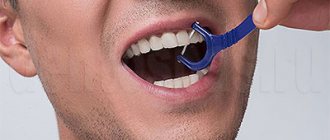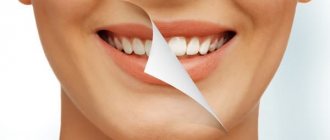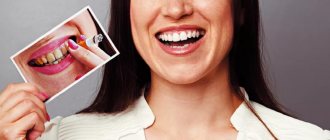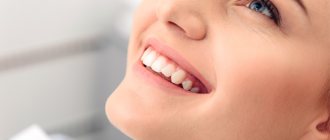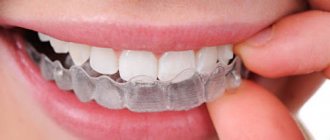Everyone wants to be the owner of a beautiful snow-white smile. This is why professional teeth whitening has become so popular recently. But in order for the result to be maximum and last a long time, you need to follow some rules for oral care. If you do not follow the specialist’s recommendations, fairly soon after the procedure your teeth will return to their previous shade.
Why do teeth become sensitive after whitening?
In the first days after the procedure, the enamel will be more sensitive; minor pain and reaction to temperature stimuli may occur. This is a completely normal phenomenon, since the teeth were exposed to aggressive external influences. However, there should not be acute pain - this situation indicates that the doctor chose the wrong dosage of the active substance.
Even the safest and gentlest whitening methods still have a negative effect on the enamel, destroying its mineral composition. Therefore, it is necessary to introduce healthy foods into the diet (see the list below), as well as use various preparations that will strengthen your teeth - in pharmacies you can purchase special pastes or compositions that are applied to the teeth for a few minutes.
What does plaque on teeth from smoking look like?
Plaque on teeth from smoking is usually yellow or brown. A few hours after brushing your teeth, the enamel is covered with a microbial film, which is easily removed with a brush and toothpaste. But in a smoker, the immune system in the oral cavity is significantly reduced and the process of reproduction of cariogenic microorganisms is more active. Therefore, a yellow-brown plaque forms faster than in a non-smoker.
You can look at what plaque on your teeth from cigarettes looks like. It differs in shade and density, depending on the duration of smoking.
Some people develop black deposits on their teeth, which indicate serious problems in oral health and may indicate the development of deep caries. Carious cavities and spots are invisible under the plaque. They can hide the initial signs of enamel damage.
In addition to plaque, other symptoms appear when smoking:
- bad breath;
- bleeding gums;
- exposure of the necks of the teeth;
- increased sensitivity of enamel;
- early tooth loss.
But infectious complications, which often arise when plaque on teeth from smoking is ignored, can be avoided. To do this, it is necessary to constantly maintain high quality oral care, carry out professional cleaning in the dentist's office and use home enamel lightening methods.
What diet should you follow after teeth whitening?
After bleaching, the enamel becomes more porous, and therefore there are certain restrictions in terms of nutrition and hygiene procedures. Therefore, after the lightening procedure, adhere to the “white diet”: exclude foods and drinks that contain coloring pigments and can lead to a change in the shade of the enamel. It is worth minimizing the amount of coffee, black tea, dark vegetables and fruits consumed.
To strengthen the enamel, introduce into your diet foods that contain large amounts of calcium and fluoride: milk, kefir, cottage cheese, fish, cheeses, eggs.
It is worth excluding factors that provoke unpleasant sensations, namely, too hard food, excessively hot and cold drinks. Follow the recommendation for an average of a week or longer, if necessary. It is also better to exclude sour and spicy foods from the diet: citrus fruits, sauces, ketchup, curry and other seasonings can increase tooth sensitivity.
Additional Tips
Here are some additional tips to help keep your teeth white:
- In the first hours after bleaching, it is important to refrain from eating food.
- It is advisable to quit smoking, since nicotine and tar from cigarettes lead to yellowing of the enamel.
- Women should be careful when using lipstick or lip gloss in the first weeks.
- To strengthen your teeth, you should increase your intake of foods with calcium.
- Mouth rinses should not contain chlorhexidine, which tends to stain enamel.
- At least twice a year, a consultation with a dentist with a preventive examination of the dentition is required.
As you can see, recommendations for caring for teeth after whitening do not pose any particular difficulties. The main thing is to strictly follow the doctor’s advice and eliminate all factors that may cause discomfort or affect the color of the enamel.
Hygienic care rules
- Do not use a toothbrush with hard bristles - it will only increase the sensitivity that occurs immediately after the whitening procedure. It is better to give preference to a brush of medium hardness, since one that is too soft will not cope with removing plaque,
- Toothpaste should be free of abrasive substances that can damage the enamel. The best option is a paste to reduce hypersensitivity. It should be used for the first 2-3 weeks after whitening. Afterwards, it can be replaced with a paste that contains fluoride - this will be an excellent option for strengthening enamel and protecting against caries,
- After eating food (especially “coloring”), you should pay special attention to hygiene - use dental floss or a irrigator after each meal. And not only in the first days after whitening, but also in the subsequent ones - this recommendation should become a useful habit,
- Mouth rinses should not contain chlorhexidine, as it causes permanent staining of tooth enamel.
Even after whitening, you need to visit the dentist 1-2 times a year (but not earlier than six months later). Professional hygiene and removal of dental plaque will preserve the results and will be an excellent prevention of caries.
Women should avoid using lip gloss and bright lipstick for the first few days after whitening.
Rules for brushing teeth
You should brush your teeth after every meal. To clean, you need to use a brush with soft bristles, since bristles that are too hard can damage the enamel. Toothpaste should be designed for sensitive teeth. It is not recommended to use products with abrasives, and when purchasing a whitening paste, it is advisable to follow the advice of a dentist.
After cleaning, you should floss between your teeth. Dental floss provides more effective cleaning and allows you to remove food particles in hard-to-reach places. At the final stage, use a rinse aid containing fluoride. Its use allows you to remove remaining dirt and strengthen the enamel.
We know how to whiten teeth
Should I use home whitening products?
It is advisable to use homemade compositions to preserve the whitening results for a long time. But these should not be folk remedies, but professional ones, selected by your dentist. It is necessary to start using such compositions no earlier than 3 months after the professional procedure. It is better if the same system is used that was used in the clinic - for example, ZOOM or Amazing White - these brands provide formulations for use at home. But for this you will need to make individual mouth guards in which the active gel will be placed.
Whitening at home is especially effective for maintaining results after a professional procedure.
Possible oral diseases in smokers
Long-term daily smoking of cigarettes contributes to the occurrence of the following pathological conditions:
- Dark coating. Smoking contributes to the formation of dark brown plaque on the teeth, which cannot be removed on your own. The problem is associated with the deposition of cadmium sulfate on the teeth, which is part of tobacco smoke.
- Gingivitis. An inflammatory process affecting the gums. The most common disease among smokers. Accompanied by bleeding during cleaning, redness and swelling.
- Periodontitis. Inflammation of the soft tissues around the tooth up to the bone, involving it in the process. Pain, even during acute infection, is not as severe as in non-smokers, as is bleeding. That is why the problem is noticed already at the stage of loosening, when it is much more difficult to treat.
- Melanosis. Formation of dark spots on the mucous membranes of the oral cavity.
- Stomatitis caused by nicotine. Inflammation of the oral mucosa with the formation of a whitish coating, swelling of the soft tissues and symptoms of irritation.
- Dry mouth. The syndrome develops due to the effects of smoke on the salivary glands and their dysfunction. The process is irreversible, so a person’s taste gradually changes.
- Leukoplakia. A precancerous condition in which the appearance of mucosal cells changes. A smoker develops white nodules on the lips, inner surface of the cheeks, tongue, and palate.
- Leukokeratosis. Another precancerous disease associated with dysplasia of the epithelium on the lips, at the site of contact with a cigarette.
Quitting smoking and brushing your teeth daily can minimize the likelihood of developing oral diseases. It should be borne in mind that a bad habit not only increases the risk of developing the disease, but also slows down its treatment and leads to complications.
General recommendations
- The daily caloric intake is up to 1500 kcal.
- Eating 5-6 times a day .
- Last dose four hours before bedtime .
- Half an hour before meals, drink a glass of water .
- Be sure to use dental floss .
Photo 2. Brushing your teeth with floss. This procedure will help maintain the whitening effect for a long time.
- Brushing your teeth should last at least 3-4 minutes .
By following these simple standards, you can maintain a white smile for several years.
Professional cleaning techniques
Teeth whitening is a common procedure in dentistry. In order to get rid of smoker’s plaque, you will have to take a comprehensive approach to this problem, that is, use several enamel cleansing techniques at once. Let's look at the most effective ways:
- Impact of ultrasound. The most famous method of removing plaque. Also works great on tartar. During the procedure, the patient does not feel any discomfort; the desired result can be achieved even in one session.
- Air flow. By the name you can understand that we are talking about air in tandem with water. The most powerful stream of abrasive qualitatively brightens the enamel without harming the teeth. For experienced smokers, this manipulation is not enough, which is why it is most often carried out as a complex measure.
- Using a laser. This method is much more expensive when compared to other types of whitening, but it will certainly solve your problem. The procedure does not harm the teeth, does not cause increased sensitivity and is absolutely safe for health.
- Chemical bleaching. In this case we are talking about various pencils, adhesive strips, gels, etc. This method does an excellent job and whitens the smoker’s enamel by several tones. In order to maintain the result for a long time, chemical whitening is carried out in 2-3 sessions.
What can and cannot be eaten on a white diet?
Since the main principle of the white diet is the exclusion of multi-colored foods from the diet of a person who has whitened his teeth, he should refuse a number of things. These include:
- Tea and coffee drinks, as well as cocoa.
- Red wine, juices, soda.
- Chocolate, candies, lollipops and other sweets.
- Vegetables, fruits and berries of bright colors.
- Ketchup and similar colorful sauces and condiments.
You should also refrain from other brightly colored foods. Since sensitivity increases after bleaching, the diet involves avoiding fermented milk drinks.
Smokers should reduce the number of cigarettes they smoke or give up tobacco altogether. The tar and nicotine present in the smoke settle on the teeth, giving them a yellowish appearance.
Are there any disadvantages?
Of course, a colorless diet has its downsides. For example, some find it very difficult to give up certain foods, leading to early relapse. It should also be noted that the diet after teeth whitening is not suitable for everyone. Contraindications include individual intolerance to dairy or other products included in the diet list. Pregnant, lactating and elderly people should also not follow the diet. We recommend that you consult your doctor first if you have problems with your stomach and digestive system in general.

